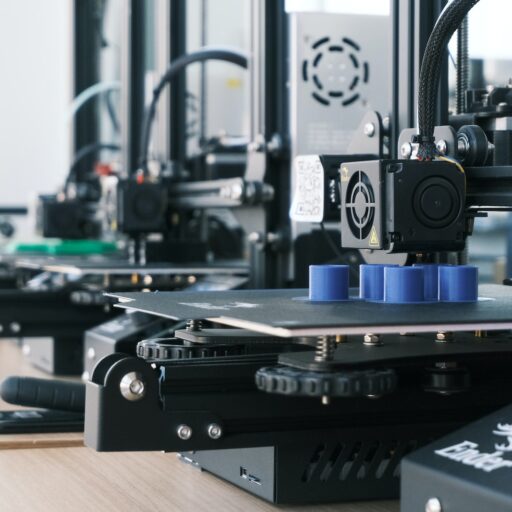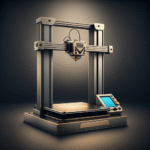Support our educational content for free when you purchase through links on our site. Learn more
Can 3D Printers Be Used Commercially? 🤔 Find Out Now!
In a world where innovation is the name of the game, the question arises: Can I use a 3D printer for commercial purposes, or are they only suited for hobbyists? This is a hot topic, especially as 3D printing technology continues to evolve and become more accessible. Imagine being able to create your own products, prototypes, or even art pieces right from your home or workshop! But is it feasible to turn that hobby into a thriving business?
In this article, we’ll dive deep into the fascinating realm of 3D printing, exploring the differences between hobby and commercial printers, when to make the leap from hobbyist to entrepreneur, and how brands like QIDI are bridging the gap. You’ll discover the essential features to look for in a commercial printer and the key factors to consider before making that investment. So, whether you’re a curious hobbyist or a budding entrepreneur, stick around to find out how you can leverage 3D printing for your goals!
Key Takeaways
- Hobby vs. Commercial: Understand the key differences between hobby and commercial 3D printers, including cost, print quality, and material compatibility.
- When to Transition: Learn the signs that indicate it’s time to upgrade from a hobbyist printer to a commercial-grade machine.
- QIDI 3D Printers: Discover how QIDI offers a unique blend of features suitable for both hobbyists and small businesses.
- Future Potential: 3D printing is not just a trend; it’s a viable option for creating products and prototypes in various industries.
Ready to explore the world of 3D printing? Check out our 3D Printer Reviews and find the perfect model for your needs! 🖨️
Table of Contents
- Quick Tips and Facts
- The Evolution of 3D Printing: From Hobby to Industry
- What Defines Hobby 3D Printers?
- Exploring Commercial 3D Printers: What Sets Them Apart?
- Key Differences Between Hobby and Commercial 3D Printers
- When to Make the Leap: Transitioning from Hobby to Commercial 3D Printing
- QIDI 3D Printers: The Perfect Bridge Between Hobby and Commercial Use
- Finding Your Ideal 3D Printer: Aligning with Your Goals
- FAQs About Hobby vs. Commercial 3D Printing
- Still Have Questions? Let’s Dive Deeper!
- Community Support: Connecting with Fellow 3D Printing Enthusiasts
- Conclusion
- Recommended Links
- FAQ
- Reference Links
Quick Tips and Facts
- Hobby 3D Printers are typically user-friendly, affordable, and great for small projects. They excel in creating prototypes, toys, and household gadgets. 🏠
- Commercial 3D Printers are designed for industrial applications, offering higher precision, faster print speeds, and the ability to work with advanced materials. 🚀
- Key Differences include print quality, speed, build size, and material compatibility. Commercial printers are built for durability and continuous operation, while hobby printers are easier to maintain.
- Transitioning from hobby to commercial printing can be beneficial when you need larger prints, higher precision, or advanced material capabilities. 🔄
- QIDI 3D Printers offer a unique blend of features suitable for both hobbyists and small businesses, making them a great choice for those looking to bridge the gap.
The Evolution of 3D Printing: From Hobby to Industry
3D printing has come a long way since its inception in the 1980s. Initially, it was a niche technology used primarily by engineers and designers. Fast forward to today, and 3D printing has exploded into a multi-billion dollar industry, with applications ranging from prototyping to manufacturing end-use products.
Why the Shift? 🤔 The democratization of technology has made 3D printers more accessible to hobbyists and small businesses alike. With the rise of affordable models, anyone can create intricate designs from the comfort of their own home or workshop.
Key Milestones in 3D Printing History
| Year | Milestone |
|---|---|
| 1981 | First 3D printing technology developed (SLA) |
| 1992 | First commercial 3D printer introduced |
| 2009 | Open-source 3D printing movement gains traction |
| 2012 | 3D printing becomes mainstream with affordable models |
| 2020 | COVID-19 pandemic accelerates demand for rapid prototyping |
What Defines Hobby 3D Printers?
Hobby 3D printers are tailored for personal use, making them perfect for enthusiasts and DIYers. Here’s what makes them tick:
Features of Hobby 3D Printers
- Affordability: Generally priced between $200 and $5,000, making them accessible for most hobbyists. 💰
- User-Friendly: Designed for ease of use, with straightforward software and quick setup.
- Materials: Typically compatible with PLA, ABS, and PETG, which are easy to find and work with.
- Print Quality: Good quality but limited resolution compared to commercial printers.
- Maintenance: Easier to maintain due to simpler designs.
Pros and Cons
| Pros | Cons |
|---|---|
| Affordable | Limited material options |
| Easy to use | Slower print speeds |
| Great for small projects | Smaller build sizes |
Exploring Commercial 3D Printers: What Sets Them Apart?
Commercial 3D printers are engineered for high performance and precision, catering to industries like aerospace, automotive, and healthcare.
Features of Commercial 3D Printers
- Higher Cost: Ranging from $5,000 to over $1,000,000, these machines are an investment. 💼
- Advanced Materials: Support for high-performance plastics, metals, and composites.
- Superior Print Quality: Finer details and better dimensional accuracy.
- Larger Build Platforms: Capable of printing larger objects or multiple smaller ones simultaneously.
- Complex Software: Often requires a steeper learning curve but offers advanced features for professional use.
Pros and Cons
| Pros | Cons |
|---|---|
| High precision | Higher initial investment |
| Faster print speeds | Requires regular maintenance |
| Suitable for mass production | Complex software |
Key Differences Between Hobby and Commercial 3D Printers
Understanding the differences between hobby and commercial 3D printers is crucial for anyone considering a purchase. Here’s a breakdown:
| Feature | Hobby Printers | Commercial Printers |
|---|---|---|
| Cost | $200 – $5,000 | $5,000 – $1,000,000+ |
| Materials | PLA, ABS, PETG | Engineering-grade plastics, metals, ceramics |
| Print Speed | Slower | Faster |
| Print Quality | Good, but limited | Superior with finer details |
| Build Size | Smaller | Larger |
| Maintenance | Easier | Requires regular upkeep |
Key Takeaway: If you’re looking to produce high-quality, functional parts, a commercial printer is the way to go. However, if you’re just starting out or working on small projects, a hobby printer will suffice.
When to Make the Leap: Transitioning from Hobby to Commercial 3D Printing
So, when should you consider upgrading to a commercial 3D printer? Here are some signs:
- Increased Demand: If your hobby has turned into a side hustle and you need to produce more items quickly.
- Need for Precision: If your projects require higher accuracy and finer details.
- Material Variety: If you want to experiment with advanced materials that hobby printers can’t handle.
- Professional Quality: If you’re looking to create products for sale or professional use.
Steps to Transition
- Evaluate Your Needs: Determine what you need in terms of print volume, quality, and materials.
- Research Options: Look into commercial printers that fit your criteria. Brands like Stratasys and Ultimaker are worth exploring.
- Consider Support: Ensure you have access to customer support and resources for troubleshooting.
QIDI 3D Printers: The Perfect Bridge Between Hobby and Commercial Use
If you’re looking for a versatile option that straddles the line between hobbyist and commercial use, QIDI 3D Printers are a fantastic choice.
Key Features
- Affordable Pricing: Offers advanced features at a fraction of the cost of traditional commercial printers.
- Material Compatibility: Works with a variety of materials, including PLA, ABS, and even some engineering-grade plastics.
- User-Friendly: Designed for both beginners and experienced users, making it easy to transition.
Why Choose QIDI?
- Versatility: Ideal for small businesses and hobbyists alike.
- Quality: Provides excellent print quality without the hefty price tag.
👉 CHECK PRICE on:
- QIDI X-Plus: Amazon | QIDI Official
- QIDI Tech X: Amazon | QIDI Official
Finding Your Ideal 3D Printer: Aligning with Your Goals
Choosing the right 3D printer can feel overwhelming, but it doesn’t have to be! Here’s how to align your choice with your goals:
Considerations
- Purpose: Are you printing for fun, prototyping, or small-scale manufacturing?
- Budget: How much are you willing to invest?
- Material Needs: What types of materials do you plan to use?
- Space: Do you have enough room for a larger commercial printer?
Tips for Selection
- Read Reviews: Check out our 3D Printer Reviews for insights.
- Join Communities: Engage with other users to learn from their experiences.
- Test Before You Buy: If possible, try out different models to see what feels right.
FAQs About Hobby vs. Commercial 3D Printing

What is the main difference between hobby and commercial 3D printers?
The main differences lie in cost, print quality, speed, and material compatibility. Commercial printers are designed for professional use, while hobby printers are more accessible for personal projects.
Read more about “What Are the Best Starter 3D Printers? Top 10 Picks for 2025! 🚀”
Can I use a hobby printer for commercial purposes?
Yes, but with limitations. Hobby printers may not provide the precision or speed required for professional applications.
Read more about “What Type of 3D Printer is Easiest to Use? Discover 10 Top Picks for 2024! 🚀”
What materials can I use with commercial printers?
Commercial printers can handle a wider range of materials, including engineering-grade plastics, metals, and composites.
Still Have Questions? Let’s Dive Deeper!
If you’re still unsure about which printer to choose or how to transition from hobby to commercial use, don’t hesitate to reach out! Our community is here to help, and we have a wealth of resources available.
Join Our Community
- Forums: Connect with fellow enthusiasts and professionals.
- Webinars: Attend sessions on 3D printing techniques and best practices.
- Support: Get answers to your specific questions from experts.
Conclusion

In the world of 3D printing, understanding the differences between hobby and commercial printers is essential for making an informed decision. Whether you’re a hobbyist looking to expand your capabilities or a small business seeking to invest in a commercial-grade machine, there’s a perfect printer out there for you.
Remember: The right choice depends on your specific needs, goals, and budget. Happy printing! 🎉
Recommended Links
- Best 3D Printer Reviews
- Beginner’s Guide to 3D Printing
- 3D Printers for Small Businesses
- 3D Printing Industry News
FAQ

-
What should I consider before buying a 3D printer?
Consider your intended use, budget, material compatibility, and space requirements. -
Can I make money with a hobby 3D printer?
Yes, many hobbyists turn their passion into a profitable venture by selling custom prints.
Reference Links
Conclusion

In the ever-evolving landscape of 3D printing, understanding the distinction between hobby and commercial printers is crucial for anyone looking to leverage this technology effectively. Hobby 3D printers are fantastic for personal projects, offering affordability and ease of use. However, if you’re serious about scaling your operations or producing high-quality, functional parts, commercial 3D printers are the way to go.
Summary of Positives and Negatives
Positives of Commercial 3D Printers:
- High Precision: Ideal for intricate designs and professional applications.
- Material Versatility: Capable of using advanced materials that hobby printers cannot.
- Faster Production: Essential for businesses needing quick turnaround times.
Negatives of Commercial 3D Printers:
- Higher Cost: Significant initial investment compared to hobby printers.
- Complexity: More advanced software and maintenance requirements.
In conclusion, if you’re looking to take your 3D printing game to the next level, investing in a commercial printer is a smart move. Brands like QIDI offer a great balance between affordability and functionality, making them suitable for both hobbyists and small businesses.
Ready to dive into the world of 3D printing? Whether you’re a hobbyist or a budding entrepreneur, there’s a perfect printer waiting for you! 🎉
Recommended Links
-
👉 Shop QIDI 3D Printers:
- QIDI X-Plus: Amazon | QIDI Official
- QIDI Tech X: Amazon | QIDI Official
-
Books on 3D Printing:
FAQ

Read more about “What is the Best 3D Printer to Buy? Top 10 Picks for 2025! 🖨️”
What are the best 3D printers for commercial use and how do they differ from hobbyist models?
Understanding Commercial vs. Hobbyist Models
Best Commercial 3D Printers include brands like Stratasys, Ultimaker, and Formlabs. These printers are designed for high-volume production and offer superior precision, speed, and material compatibility compared to hobbyist models.
Key Differences:
- Performance: Commercial printers are built for continuous operation, while hobbyist models may struggle with prolonged use.
- Material Options: Commercial printers can handle a wider range of materials, including engineering-grade plastics and metals.
- Software Complexity: Commercial printers often come with advanced software that requires training, unlike the more user-friendly interfaces of hobby printers.
Are there any specific certifications or regulations that commercial 3D printer users need to be aware of?
Compliance and Standards
Yes, commercial 3D printer users should be aware of industry-specific certifications and regulations. For example:
- ISO Standards: Many industries require compliance with ISO standards for quality management and product safety.
- Material Safety Data Sheets (MSDS): Users must understand the safety protocols for materials used in 3D printing.
- FDA Regulations: In sectors like healthcare, 3D printed products must meet FDA regulations for medical devices.
How do the costs of owning and operating a 3D printer for commercial purposes compare to traditional manufacturing methods?
Cost Analysis
Owning and operating a commercial 3D printer can be more cost-effective than traditional manufacturing methods in several ways:
- Reduced Material Waste: 3D printing is additive, meaning materials are only used where needed, unlike subtractive methods.
- Lower Setup Costs: No need for expensive molds or tooling.
- Faster Prototyping: Rapid prototyping reduces time to market, which can lead to cost savings in product development.
Can commercial 3D printing businesses use award-winning 3D printers to improve the quality and efficiency of their operations?
Leveraging Award-Winning Technology
Absolutely! Award-winning 3D printers often feature cutting-edge technology that enhances print quality and operational efficiency. For instance, printers recognized for their precision can significantly reduce the need for post-processing, saving time and costs.
In Summary: Investing in high-quality, award-winning 3D printers can provide a competitive edge in the market, leading to better products and increased customer satisfaction.




